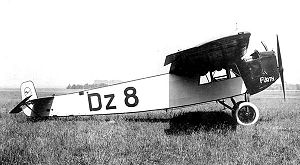Fokker F.III Video - Picture

|
|
Fokker F.III
Fokker F.III

Role: Passenger transport
Manufacturer: Fokker
Designed by: Reinhold Platz
First flight: April 1921
Primary users: Deutsche Aero Lloyd
KLM
Number built: c.66
The Fokker F.III was a single-engined high-winged monoplane aircraft produced in the 1920s by the Dutch aircraft manufacturer Fokker. It could carry five passengers. The aircraft was also built under licence in Germany as the Fokker-Grulich F.III.
Design and development
The Fokker F.III was a straightforward development of the F.II. A widened cabin allowed all five passengers to sit within; in the earlier aircraft, one passenger sat alongside the pilot in his exposed cockpit. The pilot now sat alongside the engine, which was offset laterally by about 100 mm (4 in); whether to port or starboard depended on the type of engine installed. Although this unusual arrangement meant that pilots were "burned on one side and frozen on the other," they had a much better view than from the F.II. The view was further improved by a cut-out in the wing leading edge for the pilot's head, allowing his seat to be raised. The external wing struts of the F.II were removed, leaving a clean cantilever wing. The trapezoidal windows seen in the Grulich built F.IIs were standard on the F.III.
Like its predecessor, the F.III was initially powered by a readily available, war surplus 138 kW (185 hp) BMW IIIa engine, but once again KLM re-engined theirs with the 172 kW (230 hp) Armstrong Siddeley Puma.
Operational history
The F.III was first used by KLM when they re-opened their Amsterdam-London service on 14th April 1921 (they did not, at this time operate over winter). Soon, F.IIIs were also flying on routes to Bremen, Brussels, Hamburg and Paris. They proved to be very reliable aircraft. KLM received 14 F.IIIs from Fokker's German factory at Schwerin during 1921 and built two more itself from spares in the following year. This final pair used 268 kW (360 hp) Rolls-Royce Eagle VIII engines, with the pilot on the left.
Another operator of new F.IIIs was Deutsch-Russiche Luftverkehrs Gesellschaft (Deruluft) who used nine aircraft on their Berlin-Konigsberg-Moscow route from May 1922. These machines, partially built in Schwerin and finished in Holland at Veere, had Eagle engines. One was a Fokker-Grulich.
Deutsche Aero Lloyd gained a licence to build F.IIIs as they had for F.IIs and the company, with its southern subsidiary built and operated eighteen of these Fokker-Grulich F.IIIs. Most of these used BMW engines, typically the 186 kW (250 hp) BMW IV in preference to the 138 kW (185 hp) BMW IIIa. Some of these were re-engined with the 239 kW (320 hp) BMW Va, and were designated F.IIIc.
Another operator from new was the Hungarian airline Malert, who received six Dutch built aircraft for their Budapest-Vienna-Belgrade service from 1922 to 1929. These initially had BMW IIIa motors, but later ran with 172 kW (230 hp) Hiero IVs. They had larger wings, increased in area by about 14 percent. Deutsche Luft-Reederei also operated two, originally intended for KLM. Four F.IIIs probably went to the United States
Later F.IIIs changed ownership frequently as airlines went bankrupt or merged. They were still flying commercially in Germany until about 1936.
Accidents and incidents
On 24 April 1923, Fokker F.III H-NABS of KLM departed Lympne for Rotterdam and Amsterdam. The aircraft was not heard of again. It was presumed to have crashed into the sea, killing the pilot and both passengers.
Operators
Denmark
Det Danske Luftfartselskab
Weimar Republic
Deutsch-Russiche Luftverkehrs Gesellschaft (Deruluft)
Deutsche Aero Lloyd
Deutsche Aero Luft
Deutsche Luft-Reederei
Sud-deutsche Luft Hansa
Hungary
Malert
Netherlands
Koninklijke Luchtvaart Maatschappij (KLM)
Specifications
Data from de Leeuw
General characteristics
Crew: 1
Capacity: 5 passengers
Length: 11.07 m (36 ft 4 in)
Wingspan: 17.68 m (36 ft 4 in)
Height: 3.20 m (10 ft 6 in)
Wing area: 45.65 m² (491.4 ft²)
Empty weight: 1,200 kg (2,650 lb)
Loaded weight: 1,905 kg (4,200 lb)
Powerplant: 1x— Armstrong Siddeley Puma, 170 kW (230 hp)
Performance
Cruise speed: 135 km/h (84 mph)
Range: 1,000 km (621 mi)
Bibliography
de Leeuw, Rene. Fokker Commercial Aircraft: From the F. I of 1918 Up to the Fokker 100 of Today (1994).
Weyl, A.R. Fokker: The Creative Years. London: Putnam, 1965. ISBN 0-85177-817-8.
Fokker F.III Pictures
More aircraft.
Source: WikiPedia